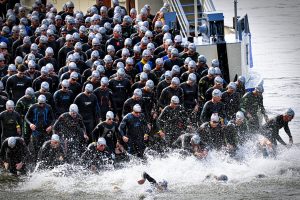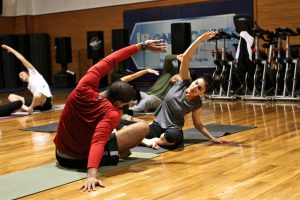Triathlon Cycling Considerations: Equipment, Technique, and Race-Day Strategy
Cycling is the longest leg of a triathlon, offering significant opportunity for both time gains and challenges. The right equipment, efficient technique, and a clear strategy can make a huge difference in your race. From choosing the ideal bike to understanding race-day etiquette, this guide covers everything you need to optimize your cycling performance and set yourself up for a smooth transition into the final run.
1. Choosing the Right Bike
Your bike is your most important piece of equipment on race day. The type of bike you choose depends on your goals, budget, and race type.
Types of Bikes:
- Road Bike: A versatile choice, road bikes are suited for both training and racing. They’re comfortable, agile, and handle hills and turns well.
- Pros: Great for technical courses with hills and tight turns; easy to train on; affordable compared to triathlon-specific bikes.
- Cons: Less aerodynamic than a triathlon bike, resulting in potentially slower times on flat courses.
- Triathlon/Time Trial (TT) Bike: Built for aerodynamics, TT bikes position the rider low and forward, reducing wind resistance.
- Pros: Ideal for flat and rolling, non-technical courses; highly aerodynamic, which reduces drag and conserves energy.
- Cons: More challenging to handle on hilly or technical courses; pricier than road bikes; less comfortable for long training rides, and typically heavier than road bikes.
- Hybrid or Mountain Bike: Rarely used in triathlons, hybrids or mountain bikes are only recommended for beginners or for non-traditional or off-road events.
- Pros: Budget-friendly, comfortable, and stable; good for off-road or short-distance races.
- Cons: Heavy and non-aerodynamic, which significantly limits speed and efficiency.
2. Cycling Kit and Accessories
Selecting the right gear can improve comfort, efficiency, and safety. Here’s a breakdown of key items:
- Tri-Suit: Designed to be worn for all three disciplines, a tri-suit reduces the need to change and minimises drag. Look for a snug fit with moisture-wicking and quick-drying fabric. Seat cushioning should reflect the distance you’re working towards.
- Triathlon Shoes: Lightweight, ventilated shoes with a stiff sole for optimal power transfer. They have quick-release straps or minimal lacing to speed up transitions.
- Helmet: Mandatory in all races, helmets come in road, aero, and TT styles. Choose based on course type—TT helmets are great for flat, non-technical courses, while road helmets offer better ventilation and maneuverability.
- Sunglasses: Protect your eyes from sun, wind, and debris. Wraparound styles provide the best protection. Choose lenses that suit race-day light conditions.
- Clip-In Pedals: Clip-in pedals provide more efficient pedaling by allowing you to pull up as well as push down. Practice clipping in and out well before race day.
Additional Tech Options:
- Electric Shifters: Simplify shifting, especially on hilly courses. They’re more precise than mechanical shifters but can be costly.
- Disc Brakes: Offer powerful braking, even in wet conditions. Many triathlon bikes now feature disc brakes for safety, though they add a bit of weight.
- Carbon-Framed Bikes: Carbon-framed bikes are popular among triathletes due to their lightweight, stiff, and aerodynamic properties. They provide excellent power transfer and speed, making them ideal for competitive races. While they’re generally more expensive and can be less durable under impact, carbon frames offer a smooth, efficient ride that enhances performance.
3. Body Position and Aerodynamics
Aerodynamic efficiency is crucial for maintaining speed without expending excess energy. Here’s how to maximize aerodynamics:
- Body Position: Keep your torso low, elbows tucked in, and hands / elbows on the aero bars if you’re using a TT or triathlon bike. This reduces frontal area and wind resistance.
- Bike Fit: Invest in a professional bike fitting to find a comfortable yet aerodynamic position. A proper fit also reduces the risk of injury and improves power transfer.
- Helmet Position: Angle your helmet slightly downward to streamline your body shape. Avoid “turtle” positioning with your head up, as it increases drag.
4. Carrying Nutrition and Hydration
During the bike leg, it’s essential to consume enough fuel and hydration to keep your energy levels stable. Check out our Nutrition guide for detail.
- Water Bottles: Most athletes use two bottles, one with water and occasionally one with an electrolyte solution. Bottle cages can be mounted on the frame or behind the saddle.
- Nutrition Storage: Use a bento box (a small storage container mounted on the top tube) to store energy gels, bars, or chews. Practice eating and drinking on the bike to avoid slowing down.
5. Mount and Dismount Techniques
Transitions are critical for a seamless race experience. Here’s how to efficiently mount and dismount:
- Mounting: Position your bike in an easy gear. Some athletes use a “flying mount” where they jump onto the bike while it’s moving, but beginners should simply mount carefully just past the mount line.
- Dismounting: Before reaching T2, slow down, unclip, and swing one leg over to prepare to run the bike in. Practice dismounting ahead of time to ensure smooth execution.
6. Discipline During the Ride: Pace and Focus
The bike leg is where many triathletes push too hard, resulting in burnout before the run. Establish a sustainable pace and stay focused on your plan.
- Pacing: Use a pacing strategy that aligns with your fitness level. Avoid surges and focus on maintaining a steady effort, especially on flat courses.
- Discipline in Transitions: Resist the temptation to go too fast at the start or at transition zones. Maintain a calm, controlled approach throughout.
7. Race Rules, Etiquette, and Safety
Race rules are in place to keep everyone safe and ensure fair competition. Understanding these rules will keep you focused on your race instead of penalties.
- Drafting: Most triathlons are non-drafting, meaning you must stay a certain distance behind other cyclists (usually 10-12 meters). Overtake quickly and avoid riding in someone’s draft zone to avoid a penalty. When passed by someone else, drop back quickly to recreate the minimum distance.
- Aid Stations and Littering: Only dispose of litter in designated zones to avoid littering penalties. Slow down at aid stations to grab hydration and nutrition safely.
- Pass on the Left: Always pass other riders on the inside, returning to the outside after passing to help keepsthe course safe and clear.
8. Race Types: Drafting and Non-Drafting
Understanding the difference between drafting and non-drafting races can help you plan your race strategy:
- Drafting Races: In draft-legal races, you can ride close to other cyclists, reducing wind resistance and conserving energy. Drafting races usually have more stringent regulations on bike types and are common in sprint and elite competitions.
- Non-Drafting Races: Most age-group and Ironman races are non-drafting. You must stay a set distance behind other riders, making aerodynamics even more important.
9. Monitoring Effort: Power, Cadence, Heart Rate, and Perceived Effort
Managing your effort level on the bike is crucial to save energy for the run. Check out our Tech guide for all you need to know.
- Power Meters: Measure wattage to gauge how much force you’re exerting. Training with power helps you establish a race-day power target to avoid over-exertion.
- Cadence: A cadence of 80-90 RPM is generally ideal for most triathletes, balancing power and endurance. Practice maintaining a consistent cadence and effort across different terrain, irrespective of speed.
- Heart Rate: Use heart rate zones to gauge effort level. Aim to stay in Zone 2 or 3 for long races, allowing you to sustain effort without burnout.
- Perceived Effort: Trust your body’s signals. On race day, nerves and excitement can affect technology readings, so use perceived effort to complement your pacing strategy.
10. Technology and Bike Computers
A bike computer is a valuable tool for tracking speed, distance, time, and cadence. Most models include GPS, power, and heart rate tracking, which are helpful for pacing and monitoring performance in real-time. Click here for more detail.
- Display Key Metrics: Set your computer to show critical information such as speed, cadence, power, and heart rate.
- GPS Navigation: In long-distance races or unfamiliar courses, GPS helps you stay on track, especially on courses with multiple loops or turns.
11. Race Officials, Littering, and Penalties
Most triathlons have race marshals who monitor compliance with rules. Here are some key guidelines to avoid penalties:
- No Littering: Dispose of litter only at aid stations to avoid time penalties.
- Penalty Box: If you receive a penalty (e.g., for drafting), you may need to stop in a penalty box during the race. Familiarise yourself with the rules beforehand to avoid penalties.
12. Aid Stations and Proper Behavior
Aid stations are opportunities to refuel, but safety is key:
- Approach Slowly: Announce if you’ll be stopping or grabbing supplies.
- Stay Alert: Look out for other riders who may suddenly slow down or stop.
13. Transition Tips: T1 and T2
Smooth transitions save time and ensure you’re ready for the next leg. Here’s how to master T1 and T2.
- T1 (Swim-to-Bike): Practice taking off your wetsuit to the waist while running. Place your helmet, sunglasses, and shoes in an organised manner for easy access. Focus on calm, efficient movements to avoid fumbling. Put the helmet on first.
- T2 (Bike-to-Run): Before reaching T2, loosen your shoes or unclip to prepare for dismounting. Keep a small, organized space in T2 with your running shoes, hat, and any nutrition ready to go.
Final Thoughts on Triathlon Cycling Success
Cycling in a triathlon is both a physical and strategic endeavour. From selecting the right bike to mastering transitions and adhering to race rules, every aspect of cycling can impact your overall race outcome. By investing time in bike skills, equipment selection, and race preparation, you’ll be ready to tackle the bike leg with confidence and efficiency. Embrace the ride, and let TriReady support your journey to triathlon success!




3 Comments